Caring for Venus flytraps and keeping them alive can be a challenge. Venus flytraps require a very specific environment to survive. But due to their popularity and fascinating nature, people grow them all over the world. In this article, I will share the care consideration for Venus flytraps all the way from beginners to advanced.
Venus flytraps require an environment with plenty of sunlight, humid soil, and nutrient-free ground. Venus flytraps thrive when they have access to feed (insects or arachnids), and they do not require fertilizers. Root rot, light-starvation, and pests are common problems with these carnivorous plants.
Venus flytrap care consideration summary:
- Light: Partial or direct sunlight for at least six hours a day
- Water type: Only water with pure water: rainwater, distilled water, or reverse osmosis water
- Watering frequency: Water frequently to keep the soil moist at all times, but not saturated
- Soil: Only employ nutrient-free soil. Pure sphagnum moss or peat moss are viable options. Here is a guide that lists the best soil options
 for Venus fly traps.
for Venus fly traps. - Feeding: Venus flytraps do not need bugs to survive, but access to feed promotes their growth.
- Pot Dimensions: Choose pots that match the size of the plant: 2 inches – 6 inches in diameter. And, always employ deep pots (7 inches)
- Pot Materials: The best-suited materials are plastic, Styrofoam, and glazed ceramic.
- Repotting: For best result, repot Venus flytraps once a year
- Trimming: Remove black leaves by cutting them from the base with scissors.
- Temperature: Venus flytraps can withstand high temperatures of up to 95 F and cold temperatures close to freezing
- Humidity: Venus flytraps can adapt to arid climates, but they benefit from high humidity environments.
- Fertilizers: There is no need to fertilize Venus flytraps.
- Dormancy: Venus flytraps go dormant during the winter for 2-3 months.
- Flowers: Flowers spur after the plant achieves maturity every spring. Skipping the flowering process by cutting the flower stalks, promotes the growth of the plant.
- Terrariums: Venus flytraps can grow in a terrarium. However, close terrariums limit their access to insects and their exposure to suitable temperatures for dormancy.
Download Venus Flytrap Care Sheet
The next sections expand on each of the topics on the list. Keep on reading to learn how to keep your Venus flytrap alive and healthy. Also, feel free to download the Venus flytrap care sheet .
.
Provide at least 6 hours of direct lighting
Venus flytraps require plenty of sunlight to be healthy.
Optimally, Venus flytraps should receive 12 whole hours of direct sunlight. But, they can live a healthy life with enough sunlight. The minimum recommended amount is 6 hours of indirect sunlight.
Growers can employ natural light, or they can supplement lighting by using a plant light.
Venus flytrap can be grown indoors in windowless homes as long as a plant light is available. You can employ high-output fluorescent lights or LED lights.
These are the grow lights I use to grow Venus flytraps. sundews, and pitcher plants indoors:
- Small plant light for 1-4 plants: https://amzn.to/2RsGlxr

- T8 LED light fixture for multiple plants (6500k Cool White): https://amzn.to/3uWoeh2

During the dormancy period, the light requirement for Venus flytrap lowers. However, they still need a few hours of sunlight every day. In the spring and summer, Venus flytraps need as much sunlight as you can give them. The inside of the lobes in Venus flytrap traps usually exhibits red coloring. When a plant has plenty of access to light, it exhibits bright red colors inside its traps. A lack of red coloring is, in many cases, a sign of little light exposure.
When Venus flytraps suffer from light-starvation, the leaf base grows, but the traps at the end of the petiole never develop. In this case, the traps look tiny in comparison to the rest of the leaf.
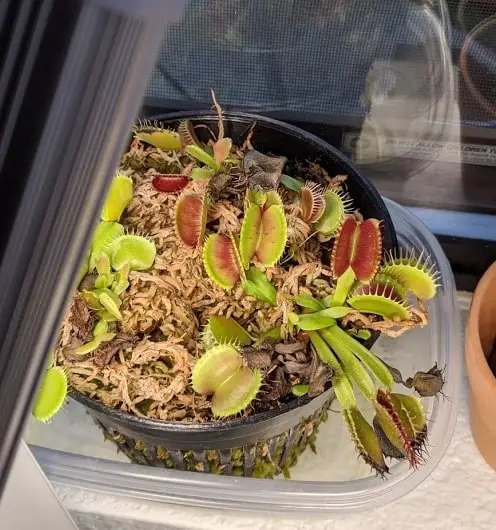
Only water with distilled water or rainwater
Tap water or bottled water contains too many minerals and nutrients to be suitable for Venus flytraps. These plants require nutrient-free mineral-free water. You can employ any source of pure water, such as:
- Rainwater
- Distilled water
- Reverse osmosis water
Make sure the water is completely pure. Some companies sell distilled water that is enhanced with minerals. Such water is unsuitable for carnivorous plants due to the added components.
When Venus flytraps are watered with the incorrect water source, they exhibit mineral burns. Some of their leaves yellow and then turn black. The yellowing of leaves is clear sign of mineral burns. To recover a Venus flytrap from exposure to the incorrect water source, the owners must repot the Venus flytrap in fresh soil and only water with pure sources.
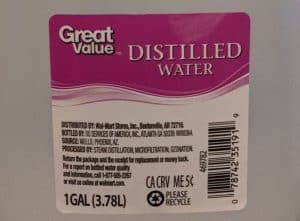
Water often to keep the soil moist at all times
Venus flytraps thrive in humid environments. The soil Venus flytraps should always remain moist; it should never be completely dry. Water the soil from the top or passively from the bottom until the soil is moist throughout.
A good way to confirm the humidity level is on point is to perform this test:
After watering, press the soil with your fingers. You should feel the moist soil, but your fingers shouldn’t get wet. Then, adjust the watering frequency through the seasons. During the spring or summer, you might have to water your plant twice a week. But, during dormancy, the watering frequency lowers substantially.
Some people believe Venus flytraps live in swamps (which is not true), and they tend to overwater. It is difficult to overwater a Venus flytrap due to its high watering requirements; however, it can happen. When Venus flytraps are overwatered, they are prone to root rot and other fungal or bacterial infections.
Avoid standard potting mixes, employ carnivorous plant soil
Employ nutrient-free mineral-free soil. Some good options for carnivorous plant soil are a mix of moss with a draining agent—for example, sphagnum moss or peat moss and silica sand or perlite as draining agents.
Several vendors offer carnivorous plant soil mixes. These are made up of a blend of the above components. You can buy a premade blend. Or you can make your own for a fraction of the plant. Here are a few recipes:
- 4:1 or 2:1 Peat moss and perlite
- 4:1 or 2:1 Sphagnum moss and Silica Sand
- 4:1:1 Peat moss, perlite and silica sand
All of the ingredients that make up the soil MUST be nutrient-free (pure). Any Miracle Grow product is unsuitable as it contains high amounts of minerals and fertilizers. Sometimes is challenging to buy pure components in general gardening stores. However, plant nurseries tend to offer much more variety.
Planting Venus flytraps in the incorrect potting soil can kill them very quickly. Repot Venus flytraps immediately to nutrient-free soil to save the plant.
Ensure your Venus flytrap has access to insects
Venus flytraps do not need bugs to survive, but access to insects promotes their growth. Venus flytraps extract key nutrients from the bugs they capture and supplement their diet.
Venus flytraps that live outdoors can capture their own prey. House plants, on the other hand, struggle to capture bugs. Then, the owners must take over the feeding process. This section will teach you the basics of how to feed a Venus flytrap:
1.- Choose The Food
Venus flytraps can consume live or dead feed. They can eat almost any type of insect or spider out there. When you feed your plant, stick to an insect and arachnid-only diet. Do not experiment with human food. The plant won’t be able to digest raw meat, candy, chicken, etc. Instead, the plant will lose a leaf, and the food will rot, attracting bacteria.

You can capture bugs to feed your plant or buy them in the pet store. I buy freeze-dried mealworms or bloodworms in the pet store. They cost less than $10 and were preserved for several years.
Both, live and dead insects provide the appropriate elements that Venus flytraps need. Venus flytraps can consume both.
Freeze-dried insects need to be rehydrated before feeding. The process is simple. Just add a few droplets of water to the bug and it is ready.
2.- Food Size
The size of the insect is important. When feeding a Venus flytrap, make sure the insect fits completely inside the trap you are feeding. A good rule of thumb is to pick a bug that is 1/3 of the size of the trap or smaller. You can also feed venus flytraps with bug pieces. When insects are too large, the plant is unable to digest them.
3.- Feeding Frequency
Only feed one trap at a time. Choose a trap and give it an insect. Then, wait until the trap has fully digested before you feed the plant again. Since the digestion process can take several days or even weeks, it is recommended to feed Venus flytraps once every two to six weeks.
4.- When Not To Feed
- During the winter months, Venus flytraps do not need to be fed.
- When Venus flytraps are seedlings or very young plants, they are too small to be fed
- Outdoor Venus flytraps have access to plenty of feed and they do not need additional feeding
- Avoid feeding when the plant is weak due to root rot, pests, repotting, etc
Only feed Venus flytraps when you have mastered the feeding technique. Feeding them can provide great advantages, but improper procedures can end up harming the plant. You can learn all the details about the feeding process, including food options and step by step instructions in this article:
Pot Venus flytraps in tall pots with drainage
Chose the appropriate dimensions for a pot depending on the size of the plant. It is best to plant Venus flytraps in an individual pot. Here is a guide to pot dimensions:
- Pot diameter: 4 to 5 inches (10.5cm – 12.7 cm)
- Pot depth: 6 inches (15.24 cm)
Young Venus flytraps can grow well in narrower containers. but regardless of their size above ground, all Venus flytraps need a deep container to extend their roots. Since the roots grow vertically, tall pots are great options.
Pot Materials
Venus flytrap can grow in a wide variety of pot materials. But, the best materials are plastic, Styrofoam, and glazed ceramic. These three options provide insulation and they do not leak any compounds to the soil within the pot.
It is best to avoid any unglazed clay pots or terracotta pots. Both materials, leak minerals to the soil. Any time of additional minerals or nutrients in the ground is harmful to Venus flytraps.
Metal and glass pots are also not recommended. Both materials do not provide good insulation against extreme heat or cold. if used, Venus flytraps can freeze solid in the winter and might boil on a hot summer day.
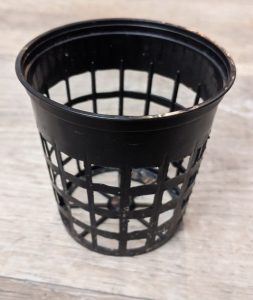
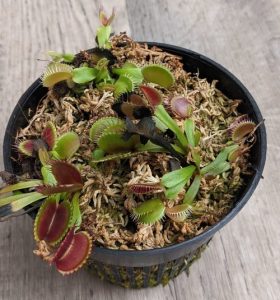
Repot Venus Flytraps once a year at the end of dormancy
For best results, consider repotting Venus flytraps every year. Soil tends to get compressed over time and limits the plant’s growth. Also, compressed soil does not provide optimal drainage. Repotting will promote growth and prevent molding (this is how you can get rid mold) and root rot.
As a beginner carnivorous plant grower, you do not have to worry about repotting immediately. First, make sure your plant is healthy. Once, you have mastered all the other elements in your plant’s setup, you can think about repotting. Moving a plant to a new pot can cause significant stress. if the plant is already weak, there is a high risk of killing it.
When to repot? The best time to repot a Venus flytrap is at the end of dormancy. Then, after repotting, the plant will exit dormancy with fresh soil and start to flourish. Repotting during spring or summer can interfere with their reproduction and growing phase.
Besides, from the yearly repotting, you must repot a Venus flytrap in these scenarios:
- The soil medium is not appropriate
- The water used was not nutrient free
- The Venus flytrap is suffering from root rot
This article can guide you through the process of how to repot your Venus flytrap .
.
Trim dead black leaves seasonally
The leaves in Venus flytraps turn to a dark black color when they wither. The withering starts in the edges and takes over the whole leaves in a matter of weeks. You can trim the black leaves in a Venus flytrap without risk, just follow these instructions:
- Wait until the leaf has wholly withered before removing. Green sections of the leaf contribute to photosynthesis.
- Grab the black leaves with your hand or tweezers to isolate it. Try your best to not activate any traps within the plant
- Use a pair of scissors and cut off the leaf as close to the base as possible (without harming the bulb). Never pull a leaf, you can rip off the plant.
Trimming or pruning a Venus flytrap will give the plant more space to grow and reduce the weight of the plant. Follow the link for a guide on trimming, You can wait until the leaves naturally decompose, but that can take years. instead, consider trimming your plant every few months.

Black leaves within the plant are normal as long as a new leaf is growing. Do not get worried when you see a single black leaf. Instead, count the total number of healthy leaves. If you notice a significant decrease in healthy leaves, then, read this article to determine the cause:
Avoid temperatures below 20F and above 100F
Venus flytraps are very resilient plants. In their natural habitat, they are exposed to high temperatures in the summer (95 F) and freezing temperatures in the winter. Follow these considerations to keep your plant healthy in extreme temperatures:
Cold Winters
Venus flytraps can live through cold winters close to freezing temperatures. However, the plant must not freeze completely. If temperatures are expected to go below 30 F, consider placing your plant indoors, in a cold (but not freezing) garage or basement. Also. sometimes insulating pot materials help keep some heat within the plant.
Hot Summers
Venus flytrap can be placed outdoors under direct sunlight in the low 90s F. But, higher temperatures can dry up these plants very quickly. During extreme summers you can:
- Bring your plants indoors
- Place them under partial shade, maybe under a shade cloth
- Limit their exposure to direct sunlight
Humidity
In the wild, Venus flytraps live in mid to high humidity levels throughout the whole year. However, these plants can adapt to lower temperature indexes. If you live in an area that provides a regular 50% humidity in the environment, your Venus flytrap will have no issues adapting.
Arid climate can be a challenge for Venus flytraps. But, they can adapt. I grow Venus flytraps in Arizona, and the desert climate does not stop them. The best way to acclimate plants to lower humidity is to make a slow transition: Consider misting your plants to increase humidity and slowly reduce the misting over time.
Also, you can consider placing the Venus flytrap pot on top of a container with water. With this method, you can water your plant from the bottom, and the remaining water in the plate will increase the humidity in the area. The image below illustrates the method. You do not need a deep container, an inch of water is sufficient.
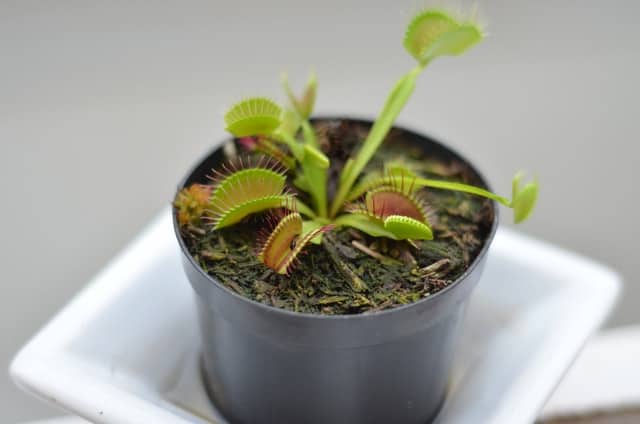
Terrariums provide high humidity, but they are not optimal for Venus flytraps.
Do not fertilize Venus flytraps
Avoid fertilizing Venus flytraps altogether. Fertilizing a Venus flytrap can kill it if done incorrectly. The excessive use of fertilizers can poison the plant with added nutrients. Most plants thrive with fertilizer, Venus flytraps are the opposite. Instead of fertilizing, Venus flytraps prefer to be fed bugs. Then, they can assimilate the nutrients.
As you get more experienced, you can experiment with fertilizers. Still, you must be very careful. Follow these rules:
- Only fertilize Venus flytraps during the spring or summer
- Do not fertilize if the plant has been fed frequently
- Employ weak foliar spray fertilizers
Ensure your Venus flytrap goes dormant in winter
In their natural habitat, Venus flytraps experience dormancy every year. Dormancy is a hibernation period when the plant rests and gets ready for the spring.
The Venus flytrap dormancy period lasts 3-4 months and it is essential for the plant’s development. Venus flytraps can survive without dormancy, but their life expectancy lowers significantly, they only live 2 – 4 years (much less than 20).
Keep your plant alive for decades by ensuring it goes dormant every winter.
Since the dormancy process is essential for Venus flytraps, owners must ensure their plant undergoes dormancy once a year.
Venus flytraps undergo dormancy when they are exposed to temperatures below 45 F for several weeks. Then, they stay dormant for 3-4 months and slowly exit dormancy, and start to flourish.
Consider placing your plant outside, in a cold garage, or on a porch to expose them to low low temperatures and start dormancy.
How to exit dormancy? In most cases, Venus flytraps will exit dormancy as the weather gets warmer. However, in locations with very long winters, Venus flytraps can struggle to exit dormancy. In those scenarios, owners can slowly introduce the plant to more lighting and warmer temperatures by placing them indoors.
What to expect during dormancy? During dormancy, Venus flytraps change significantly. The plant reduces in size and it losses most of its leaves. An increase in black leaves is completely normal during this period.
Do Venus flytraps die if they skip one dormancy? Venus flytraps do not die if they do not go dormant one year. However, skipping dormancy for several years will end up killing the plant. Dormancy is essential.
Avoid the flowering process to promote growth
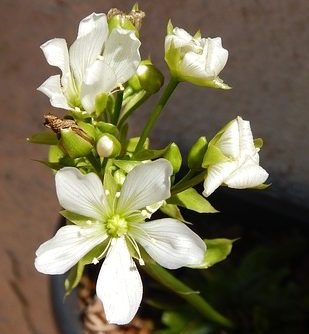
In the spring Venus flytraps produce flowers. Their flowers are white and they exhibit green veins through the petals.
The flowering process won’t hurt your plant directly, but it will drain your plant’s energy.
The general recommendation is to skip the flowering process if you are not interested in collecting seeds. When the flower stalks start to spur from the plant, use some sharp scissors to cut them off. The flower stalks are quite different from standard leaves. They are much thicker and are cylindrical.
The faster you cut them off, the more energy your plant will save for the growing season. When Venus flytraps flowers, they produce several flower stalks. Keep an eye for all of them and remove them.
Do not grow Venus Flytrap in terrariums
Venus flytraps can grow in a terrarium. However, they do not provide optimal conditions for their growth. Terrariums provide good humidity levels, which is beneficial. But, in close terrariums, Venus flytraps do not have access to feed and they cannot receive direct sunlight. Also, due to the lack of drainage, Venus flytraps tend to suffer from root rot when placed in terrariums.
Some Venus flytraps are sold in built-in terrariums or domes. The close structure is meant to keep a high humidity level. But, these enclosed packages are not optimal for Venus flytraps. First, the dome blocks the light. Second, the plant can’t consume bugs. Third, the enclosure can overheat the plant when placed close to a light source. For best results, remove the plant from the dome and pot in a standard plant pot with drainage holes.

Download Complete Venus Flytrap Care Sheet (Free)
Venus Flytrap Care Setup
Growing a Venus flytrap in the right setup ensures your plant will stay healthy and thrive.
I have experimented with different setups for my carnivorous plants and in this section, I will guide you to build the best possible environment for your Venus flytrap.
Venus flytraps grow well outdoors under direct sunlight for at least 6 hours a day. You must pot the plant with carnivorous plant soil and water it often to keep the soil humid at all times. Avoid fertilizers and temperatures below 20F and 90F.
Even though, growing Venus flytraps outdoors is optimal, it is also possible to grow Venus flytraps indoors.
Grow Venus flytraps indoors by either placing them in a sunny windowsill or employing artificial lighting for at least 6 hours a day. Water frequently with distilled or rainwater to keep the soil humid, but look out for overwatering signs like mold, algae, or root rot.
Overall, make sure you follow the advice in this table to build an effective setup for your plant:
| Light | Provide over 6 hours of sunlight or artificial lighting |
| Soil | Employ carnivorous plant soil |
| Pot | Use plastic or glazed ceramic pots with drainage |
| Water | Water frequently to keep the soil humid at all times with distilled or rainwater. |
| Temperature | Avoid temperatures below 20F and above 100F |
| Location | For best results, grow Venus flytraps outdoors |

